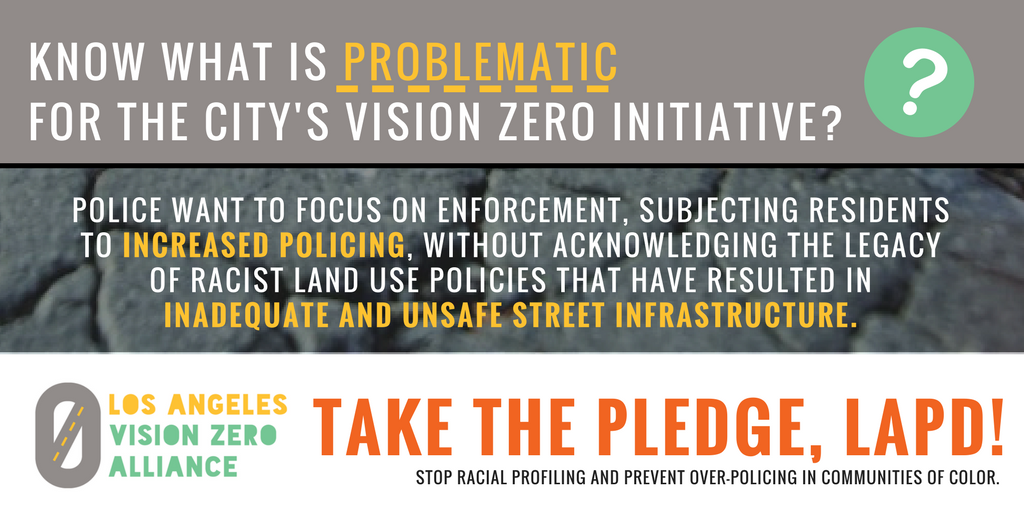Two years ago today, Los Angeles Mayor Eric Garcetti signed his Vision Zero mayoral directive, setting the city on track to end all traffic deaths by 2025.
Unfortunately for Garcetti and the rest of L.A.'s residents, the results so far have trended badly. According to the Los Angeles Times, "in 2016, the first full year that Garcetti’s Vision Zero policy was in effect in L.A., 260 people were killed in traffic crashes on city streets, an increase of almost 43 percent over the previous year" and, at least as of April 2017, traffic deaths were running 22 percent higher than 2016.
Some critics are quick to blame L.A.'s Vision Zero programs for the unhealthy trend. Playa Del Rey road diet critics cite their own documentation showing a doubling of "accidents" since Vision Zero safety improvements were implemented. (If true, this would argue for more traffic calming, though that is not the conclusion they come to.)
The actual reasons for the alarming trend appears to have more to do with increased driving, low gas prices, a strong economy, and a lack of political will to take Vision Zero seriously. The program was barely funded for the first two years, until council leadership recently shepherded $27 million for the current fiscal year which just began on July 1. On top of the paucity of funding, several councilmembers have actively blocked safety improvements in their districts.
To mark the anniversary, the city Transportation Department (LADOT) put out a press release touting work accomplished so far, including:
In the last six months, LADOT has installed 404 new upgraded crosswalks, 109 new “speed feedback signs,” and 117 new “intersection tightenings” along the Priority Corridors (picture below). These projects comprise the complete Phase 1 improvement projects on 15 Priority Corridors; 25 additional corridors are in the planning phase.
Vision Zero Los Angeles’ education and outreach efforts have been multi-faceted, in an effort to shift the conversation in Los Angeles on traffic collisions. This campaign has included:- Billboards installed on corridors suffering the highest number of fatal and serious injury collisions with the message “At 40 mph on Hoover, even a good driver’s car can be deadly.”- Week-long creative traffic safety campaigns along the High Injury Network hosted in partnership with local community-based organizations. Using this direct outreach strategy, these campaigns reached over 23,000 Angelenos.- A Digital Memorial Map honoring those killed in traffic collisions since 2003.- LADOT’s first “Creative Catalyst” Artist-in-Residence Alan Nakagawa used creativity to engage the LA community on Vision Zero, from Vision Zero-themed “Zines” and community-sourced Street Haikus about safety and life on Mar Vista’s Venice Blvd to a 2016 World Day of Remembrance event in which 30 artists performed or installed artwork commemorating traffic fatalities along Spring and Main in Downtown LA.
The Safe Routes to School program is an integral part of the Vision Zero initiative that focuses on ensuring children are safe while traveling to-and-from school. To date, the program has upgraded crosswalks at the Top 50 schools (identified through an analysis of collision data, population density, and socioeconomic information), reduced speed limits in school zones and partnered with law enforcement to do outreach at 11 schools, collected school-based data at seven schools, and supported 398 Walk to School Day events. The program has secured $22.5 million in state funding for street improvements, Safe Routes to School plans for the Top 50 schools, and education and enforcement programs.
In an article on the anniversary, the L.A. Vision Zero Alliance, a coalition of non-profits working toward Vision Zero, cite "a mixed record of achievement in its first two years." Today the Alliance released its policy platform and guiding values document, which includes the following:
FUNDING
1. Allocate sufficient funding to the implementation of street improvements that will achieve Vision Zero benchmarks. Prioritize and fund projects equitably, focusing resources on low-income communities and communities of color.2. Leverage new transportation and housing funding sources to invest in coordinated anti-displacement measures along Vision Zero corridors and other high priority areas where transit-dependent residents are at risk of displacement.3. Increase funding for community-based organizations to educate and engage with residents and stakeholders during project development and implementation.4. Incorporate citizen/community oversight and public accountability of all Vision Zero funding allocated to enforcement.
COMMUNITY ENGAGEMENT
1. Develop guidelines, standards, and budget requirements for deep community engagement that ensures accessibility, cultural competency, and consistency across departments.2. Follow established guidelines and standards in order to engage and, when appropriate, compensate community members, stakeholders, and advocates in the project development and implementation process.3. Tie enforcement strategies to outreach, education, and ticket diversion programs as more holistic and effective alternatives to fine-based enforcement.
TRANSPARENCY AND ACCOUNTABILITY
1. Clarify the roles and responsibilities of all City agencies affiliated with Vision Zero projects. Explain how agencies collaborate, and make each agency’s Vision Zero project plans and progress publicly available in one place.2. Ensure the City’s Vision Zero Plan and Safe Routes to School Plan are aligned with one another.3. Adopt a no racial profiling pledge that clarifies how the Los Angeles Police Department will implement education and enforcement to avoid harassment and violent interactions between officers and community residents.4. Make demographic, geographic, and typology data available regarding traffic citations; develop and implement a regular public tracking method.5. Establish a requirement mandating the City of Los Angeles to draw upon national best practices in street design whenever redesigning streets and intersections to improve safety for all road users







